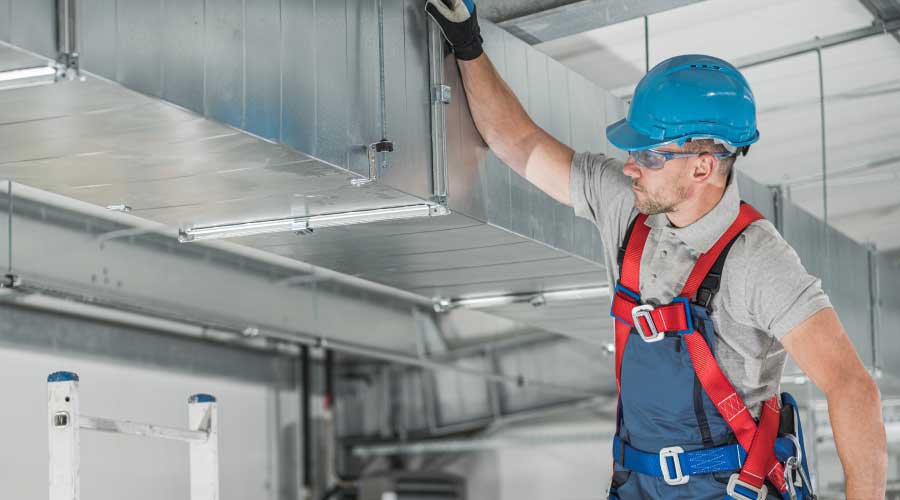 The city of Louisville's upgrades to its municipal buildings are projected to produce annual energy savings of $2.7 million, for a total of $56 million over 25 years, all in an effort to help the city reach its goal of cutting per capita energy use 25 percent by 2025.
The city of Louisville's upgrades to its municipal buildings are projected to produce annual energy savings of $2.7 million, for a total of $56 million over 25 years, all in an effort to help the city reach its goal of cutting per capita energy use 25 percent by 2025.New HVAC Technology Can Deliver Benefits Beyond Bottom Line
$27 million in energy efficient upgrades bring new technology and savings to Louisville's municiple buildings.
Municipal facilities in Louisville had reached a tipping point, and city officials knew it. As is the case with many cities and states — not to mention K-12 school districts and public colleges and universities — years of deferred maintenance had taken a heavy toll. Facing limited resources to address a growing backlog of work orders, facility managers and their staffs were able to keep aging facilities and systems operating, though not energy efficiently in many cases.
“For years, we had been Band-Aiding our systems, and you can only do that so much,” says Cathy Duncan, Louisville’s director of facilities. “We had to make improvements. It wasn’t a case of want to. We had to.”
The city’s response to its deferred maintenance problems and the growing need for energy efficiency came in 2013 in the form of two energy performance contracts totaling nearly $27 million in energy-efficient upgrades and repairs in nearly 200 facilities.
Meeting the challenge
Louisville’s maintenance challenges arose from the financial issues that confound many institutional and commercial facilities. Properly maintaining buildings is rarely the core mission of any organization. As a result, the bulk of an organization’s funds go toward its core mission, leaving maintenance and engineering managers and their staffs to do more with less.
“Like most municipalities, our facilities suffer from a lack of funds for deferred maintenance,” Duncan says, adding that many buildings and systems were well past their useful lives. “We did not have the capital to upgrade them ourselves. This was a creative way to get a large infusion of new equipment that reduces our maintenance time and provides a better environment for all of our occupants.”
Under the contracts, the city’s partner, Johnson Controls, provided upfront capital to update facilities and HVAC systems, with payback coming via resulting energy savings. The projects, targeting outdated and inefficient systems and components, included water conservation efforts, lighting upgrades, HVAC upgrades, solar panels, and building management system controls designed to improve facilities’ energy efficiency and sustainability.
The upgrades are projected to produce annual energy savings of $2.7 million, for a total of $56 million over 25 years, all in an effort to help the city reach its goal of cutting per capita energy use 25 percent by 2025. The upgrades already have reduced facilities’ water use by 395,000 gallons in less than a year and are expected to reduce carbon dioxide emissions by 19,900 metric tons annually.
“There were actually two energy performance contracts,” says Mark Zoeller, the city’s assistant director of facilities. “The first one was a much smaller grouping of 25 buildings. The second one had a much broader scope and touched agencies throughout metro government.”
Zoeller points to upgrades of the city’s Hall of Justice as perhaps the most challenging of the projects.
“It was built in the early 1970s, and very little had been done as far as the upkeep of the facility, so we probably had the largest impact in that facility,” he says. “It was also one of the largest challenges because portions of the Hall of Justice operated 24/7.
“Throughout this whole process, I described it as changing a tire on a moving car. We were changing out boilers and chillers, and we did the best we could to change those out in all seasons and not impact people, but when you’re dealing with people’s comfort, there are a whole lot of challenges.”
The building’s operations also created a number of challenges.
“The building is one of our courts, so they do domestic violence intakes there, and there are holding cells for inmates,” he says. “It is very active. I’ve heard that it’s the most visited building in the state of Kentucky.”
Despite the challenges, the Hall of Justice upgrades also were the most impactful, Zoeller says. “Over both contracts, we touched a majority of our facilities,” he says. “But a facility might only have had smaller things done. We might only have replaced lighting in a facility, for instance. But basically, we touched every aspect of the Hall of Justice, from its weather tightness to boilers, chillers, lights, and VAVs throughout the building. It seemed like it had the most work going on of all the facilities.”
Related Topics:














